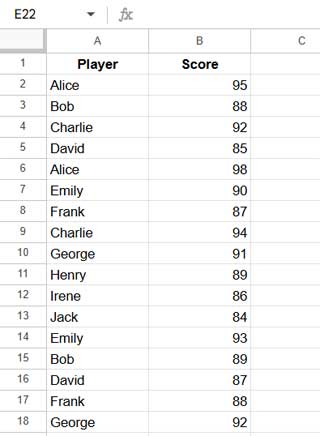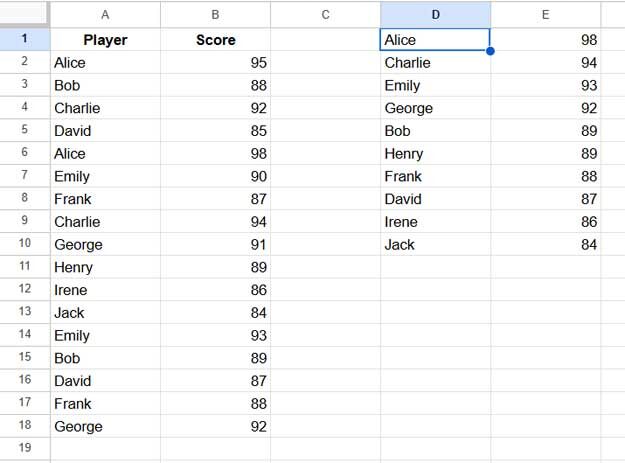In several scenarios, you might need to find the top 10 unique names by the score in Google Sheets. This is commonly used in sports rankings, gaming leaderboards, and academic competitions where multiple attempts exist. The goal is to ensure that each participant appears only once, with their highest score considered.
You can achieve this using either a combination of SORT and SORTN or the QUERY function.
How to Find the Top 10 Unique Names by Score in Google Sheets
Formula Option 1: Using SORT and SORTN
=SORTN(SORT(SORTN(SORT(A2:B, 2, FALSE), 9^9, 2, 1, TRUE), 2, FALSE), 10, 0, 2, FALSE)Formula Option 2: Using QUERY
=QUERY(A2:B, "select Col1, max(Col2) group by Col1 order by max(Col2) desc limit 10 label max(Col2)''")When using these formulas, replace A2:B with your actual data range, where column A contains names and column B contains scores.
Google Sheets Example: Find Top 10 Unique Names by Score
Sample Data

In the sample data, column A contains player names, and some players appear multiple times. In such cases, only their highest score should be considered.
Applying the Formula
To display the top 10 unique players by score, enter one of the formulas above in D1 (if columns D and E are empty). The results will populate in D1:E10.

How the Formula Works
Below is an explanation of how both formulas work. They are simple to understand—let’s dive in!
SORT + SORTN Method
SORT(A2:B, 2, FALSE): Sorts the scores in descending order (highest to lowest).SORTN(..., 9^9, 2, 1, TRUE): Selects all unique names, keeping only their highest score.SORT(..., 2, FALSE): Ensures the results remain sorted by score.SORTN(..., 10, 0, 2, FALSE): Extracts the Top 10 scores from the sorted, unique-player list.
QUERY Method
group by Col1: Groups rows by player names (removes duplicates).max(Col2): Extracts each player’s highest score.order by max(Col2) desc limit 10: Sorts scores in descending order and selects the top 10.
- As a side note, between the two functions, I prefer the powerful SORT and SORTN combo over QUERY, as it performs better. QUERY processes structured queries similar to SQL, which can slow performance when working with very large datasets or applying multiple queries to the same dataset.
How to Find the Top 5 Unique Names by Score
If you need the top 5 instead of the top 10:
- In SORTN, replace
10with5. - In QUERY, replace
limit 10withlimit 5.
Example: =SORTN(SORT(SORTN(SORT(A2:B, 2, FALSE), 9^9, 2, 1, TRUE), 2, FALSE), 5, 0, 2, FALSE)
That’s it! You can now easily find the top unique names based on score in Google Sheets.
Top 10 Unique Names by Score + Additional Names if Tie in Nth Highest
One advantage of using the SORT + SORTN combination to find the top N unique names in Google Sheets is that it can dynamically include additional names if there’s a tie at the nth score.
To achieve this, simply replace tie mode 0 with 1 in the outer SORTN, as shown below:
=SORTN(SORT(SORTN(SORT(A2:B, 2, FALSE), 9^9, 2, 1, TRUE), 2, FALSE), 10, 1, 2, FALSE)FAQ: Common Questions About Ranking in Google Sheets
How do I rank without duplicate names in Google Sheets?
Use SORTN or QUERY to remove duplicates and keep only the highest score.
Can I find the top 10 without using QUERY?
Yes! Use SORT and SORTN combo to get the top 10 unique names by score.
How do I assign ranks after finding the top 10?
You can use the RANK.EQ or RANK.AVG functions alongside the formulas above. For example, after clearing F1:F, enter the following formula in cell F1.
=ArrayFormula(IFNA(RANK.EQ(E1:E, E1:E)))Resources
- Ranking a Non-Existing Number in Google Sheets Data
- Rank Without Duplicates in Google Sheets
- How to Use the RANK.AVG Function in Google Sheets
- The PERCENTRANK Functions in Google Sheets
- How to Rank Group Wise in Google Sheets in Sorted or Unsorted Group
- Find the Rank of an Item in Each Column in Google Sheets
- Highlight Top 10 Ranks in Single or Each Column in Google Sheets
- How to Rank without Ties in Google Sheets
- How to Rank Data by Alphabetical Order in Google Sheets
- How to Rank Text Uniquely in Google Sheets





















